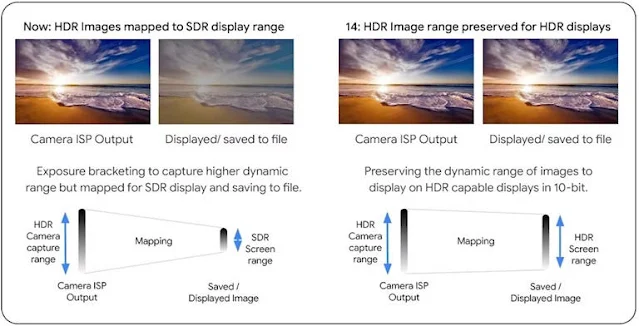In the dynamic world of smartphone photography, each advancement is a step closer to capturing life's moments with unparalleled clarity. Android 14's Ultra HDR, showcased prominently in the Pixel 8 series, stands as a game-changing technology redefining the way we perceive and immortalize our surroundings. This article delves deep into the intricacies of Ultra HDR, exploring its features, working mechanism, and the transformative impact it brings to Pixel 8's camera capabilities.
Understanding Ultra HDR: A Paradigm Shift in Photo Quality
The Evolution from HDR to Ultra HDR
 |
| Android 14's Ultra HDR: Pixel 8's Game-Changing Photo Technology |
Smartphones, especially those under the Pixel 8 banner, have always pushed the boundaries of camera technology. While HDR (High Dynamic Range) attempted to bridge the gap in reproducing scenes as the human eye sees them, Ultra HDR takes it to the next level. It's not merely an enhancement; it's a paradigm shift.
The Ingenious Integration: Ultra HDR in Pixel 8
Ultra HDR operates as a revolutionary way of storing and displaying images, introducing a subtle yet powerful twist to JPEGs. The images retain the familiar .jpg extension, but behind the scenes, a hidden gem, the HDR gain map, is at play. This piece of data guides the device in boosting brightness, contrast, and color, elevating the image quality to new heights.
The Mechanics Behind Ultra HDR: A Closer Look
HDR vs. Ultra HDR: Breaking Free from Tone Mapping
Unlike its predecessor HDR, Ultra HDR breaks free from the constraints of tone mapping. Instead, it relies on gain maps – intricate data embedded in the metadata of JPEG files. This strategic approach eliminates the overprocessed look often associated with traditional HDR shots, offering users a more authentic representation of their captured moments.
The Display Dilemma: SDR vs. HDR
Ultra HDR images can be viewed on any device capable of displaying JPEGs, but the magic truly unfolds on HDR displays. On standard SDR (Standard Dynamic Range) screens, the Ultra HDR images maintain a semblance of normal JPEGs. However, when viewed on an HDR display, the HDR gain map works its magic, creating a vivid, lifelike image that transcends conventional photo quality.
Experiencing the Ultra HDR Magic: Day and Night
Daylight Wonders: Enhancements Beyond Expectations
In broad daylight, Ultra HDR unveils its true potential. The gain map subtly adjusts brightness, contrast, and color, offering an image that not only preserves the details but enhances them. Imagine capturing the perfect sunset, and upon viewing it, noticing how the sun shines with an unmatched brilliance, or how the gleam on a car's surface becomes an art form in itself.
Nighttime Illumination: Transformative Realism
As the sun sets, Ultra HDR continues to impress. Night shots, often challenging for traditional HDR, become a playground for Pixel 8's camera. The lights of a car appear genuinely illuminated, and billboards seem to emit their own light, a feat unmatched by SDR displays and even standard HDR photos.
Getting Started: Pixel 8 and Beyond
The Exclusive Pixel 8 Experience
For now, the privilege of capturing Ultra HDR photos resides with Pixel 8 and Pixel 8 Pro users equipped with the latest Camera app. Android 14 devices seamlessly recognize the format, but to witness the true enhancements, an HDR display is a prerequisite. Fortunately, most mid-range handsets now support HDR, bringing the transformative power of Ultra HDR to a broader audience.
App Integration: Google Photos Leading the Way
To fully experience Ultra HDR, it's not just about the device; the app you use matters. Google Photos takes the lead in supporting Ultra HDR format, ensuring users can view, edit, and share their enhanced images seamlessly. Chrome and various Chromium-based browsers also join the league, making the Ultra HDR experience accessible across multiple platforms.
Challenges and Future Prospects: A Fragile Yet Promising Format
Fragility in Social Media Realm
While Ultra HDR opens new doors, it faces challenges in the social media landscape. Social platforms, known for compressing images during uploads, may pose a threat to the HDR gain map. However, as adoption grows, it's anticipated that these platforms will adapt, allowing users to share their Ultra HDR creations effortlessly.
Enabling Creativity: The Future Unveiled
As Ultra HDR gains momentum, the possibilities for creative expression multiply. Creators are poised to leverage this technology to unleash new dimensions in photography, from vibrant stickers to captivating brightness effects. The future promises a landscape where users can amplify their creativity through the transformative lens of Ultra HDR.
Conclusion: A Pixel 8 Photographic Renaissance
In conclusion, Android 14's Ultra HDR technology, embedded in the Pixel 8 series, marks a significant leap forward in smartphone photography. It redefines the boundaries of image quality, offering users an unprecedented level of realism and vibrancy. From the exclusive Pixel 8 experience to the challenges and promises of a fragile format, Ultra HDR stands tall as a revolutionary force, ushering in a new era of creative expression in mobile photography. As social media platforms adapt, we can anticipate a seamless future where the brilliance of Ultra HDR becomes a shared experience among photography enthusiasts worldwide.
